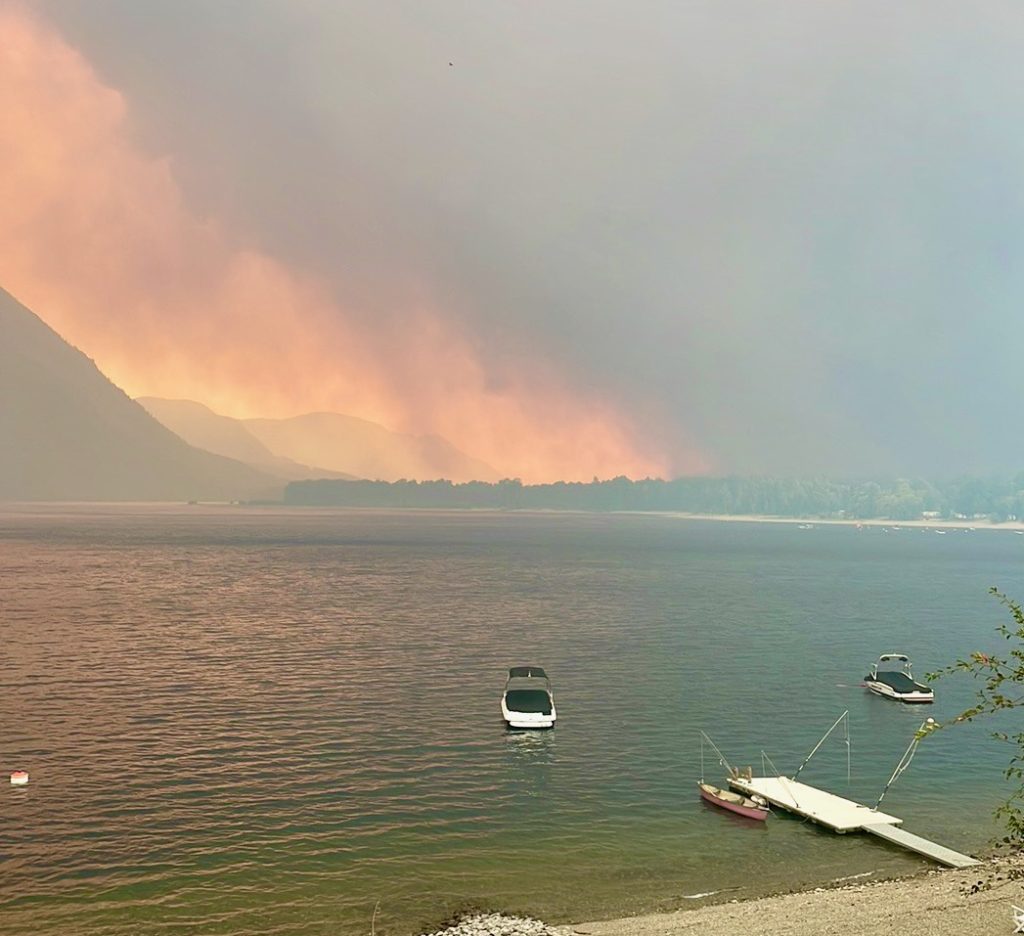
While there were a few hundred residents who remained behind to protect their homes and their neighbour’s homes and properties, some of them deserve extra recognition for what they accomplished by going above and beyond the call of duty. North Shuswap industrialists Matt and Craig Spooner, who spent fifteen years with the local volunteer fire department, actioned fires and provided key assistance to many others in the community during and after the firestorm.
Knowing it was not a question of if, but when the fire would threaten homes, Craig made sure that he and his team were prepared. On August 17th, when the BC Wildfire Service (BCWS) was preparing to ignite their massive backfire, he was in Kamloops purchasing thousands of dollars’ worth of pumps, hoses, nozzles and fittings, while his team was prepping their five water trucks. Craig also took the time to phone many of his neighbours to get their permission to access their land if needed to fight fires.

After watching the huge smoke plume rise above the hillside from the backburn, he decided to go to bed knowing that he would not be getting much rest in the days ahead. But his sleep was interrupted at 11 pm when he received an urgent phone call and learned about how the backburn was already at the west end of Meadow Creek. He was soon helping Dave Dyke and his neighbours fight the blazes with his water truck and thankfully all the homes were saved. Meanwhile, the BCWS crew was parked safely back up the valley observing the firestorm advancing towards them in the hills.
On Friday morning, the day of the firestorm, Craig and Matt focused on developing a plan for what was to come and wetting down his shop area near the Adams River. He also helped set up a sprinkler system in his neighbourhood on Simpson Road. When the winds picked up that afternoon, the West Bush Creek fire roared across the Adams River quickly and began burning the trees above the Spooner shop.

With fires raging to the west and north, there were soon spot fires in their industrial yard and the Spooner team were kept active dousing the flames. It was not long before the smoke was so intense that they were forced to retreat to Simpson Road, where they made sure all the sprinkler systems were going full blast. When the smoke cleared, they returned to the yard to extinguishing more spot fires, including those in their bins.

Thankfully, the Spooner group had a contract with the CSRD to maintain their water systems and thus he had a permit to drive on the roads. In addition to fighting fires, Craig was able to use generators to run the pumps for the systems in Scotch Creek, Celista and Anglemont, as well as helping with the system for Lee Creek Heights. Using his pass, he was also able to help provide fuel and other essentials to other neighbourhood teams who were busy putting out spot fires in their neighbourhoods.

During the days after the firestorm, the major threat to the Lee Creek community was from the fire still raging in the Corning (Lee) Creek canyon. Craig assisted his neighbours who lived on both sides of the canyon with his excavator and water truck. Fortunately, both BCWS and volunteer fire department crews arrived to help when the blaze roared up the slope on Monday and on the following day a helicopter was used to bucket water. To the east, Matt worked with his neighbours on another fire guard that prevented the fire from heading west into the Lee Creek Heights neighbourhood.
The North Shuswap is fortunate that the Spooner industrial team, along with its water trucks and supplies were there when needed. There is no doubt that many more homes would have burned in the days after the firestorm without the heavy equipment, water trucks and expertise used by the Spooner team.
POSTSCRIPT
It was back in the summer of 2009, when Craig first had to cope with BCWS intransigence regarding the need to action fires quickly. When a vehicle hit a power pole across from McKay Bay, it sparked a blaze that soon threatened the entire community. Fortunately, Craig and others were there almost immediately with an excavator and water truck. However, the trees were already on fire, so a local logger began falling these to prevent the fire from spreading. When a young BCWS employee showed up, she insisted the faller had to stop because he was not certified. Craig simply refused until all the trees were down and the danger was over.
During the first few days after the firestorm, Spooner trucks delivered water to the structural protection systems installed by BCWS contract crews and provided fuel for the pumps, because the government crews were scrambling after having to evacuate their burned-out camp at Squilax. Once they returned in force, Spooner was told that because his trucks were not “certified,” they would no longer be needed and months later they finally reimbursed him for the cost of the fuel.
Although at times there was some collaboration between BCWS and local neighbourhood firefighters, there were also conflicts. The government avoids taking risks and at times they would try to enforce their rules that included not using machinery on steep slopes or using excavators to push dirt on fires. Yet, using uncertifiable, but tried and true methods is one of the advantages that locals have over the government crews and as a result, many homes were saved.






